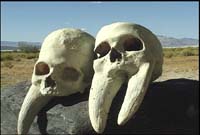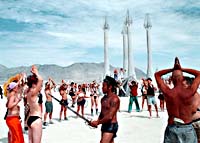Dream Sequence 9
Phase five: To the desert
The time had come for Pepe and a small crew to load up a big truck with the eight temple-guardian sculptures, a ton of tools, and all the materials to build the set and the Rudran camp. I followed, shooting the construction on-site in Nevada for three weeks before the festival opened to the public. This began another kind of unique shooting challenge.
 |
A wind sock or foam screen on your microphone is absolutely necessary to prevent big boomy noises in the audio recording. A UV filter is a great thing to have over your lens to protect it from scratches and knock down some of the light intensity. Controlling brightness is a real art. The worst thing about shooting in DV for potential broadcast is capturing at too bright a luminance level ("blowing out" the whites) to where you can no longer see much detail in them. At the same time, the colors in the desert light are so stunning that you don't want to knock down the exposure to the point that things start to look dull. I found a careful balance of exposure control by using the exposure dial, the built-in neutral density filter, and the -3db gain setting in the menu of the VX1000. The combination yielded good results, but it was a situation I was constantly monitoring and updating. I was glad to have experimented with these kinds of settings before I left home.
 |
The best thing that happened out of this whole experience was that I gained the sensitivity I needed to document someone experiencing a personal moment. I felt that this unique group of people let me access their private thoughts and feelings in a very intimate way. I felt acutely sensitive to when it was OK and not OK to turn a camera on somebody. More often than not, having established a little trust and projecting an honest, nonexploitive intention, I was able to capture moments of great humanity in the midst of all this madness. It comes through on the screen.